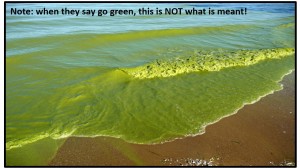Holy Toledo! Who would have thought that a city on the Great Lakes would suffer from a lack of potable drinking water? But that is exactly what happened over the weekend in Toledo, OH (population 400,000). The cause? Algae blooms. The cause of the algae blooms? Excess nutrients. The source of the excess nutrients? Fertilizers and manure from farms and lawns (just to be clear, the manure is from the farms!).
Sadly this nightmare scenario seems to be more and more common with some estimates claiming that up to 30% of larger water bodies in the US being impacted. The heavy rains we’ve experienced this summer are definitely a contributing factor too.
So how exactly might biochar help reduce this from happening around watersheds? It’s not really all that complicated. I’ve mentioned in previous posts that biochar is great at holding onto nutrients and other substances. Specifically though, farmers could mix biochar into their manure spreaders which will not only hold on to the nutrients longer, but it will probably make the neighbors happy by minimizing ‘l’odeur du poo’. Established lawns are a bit trickier. It’s not really advisable to top dress biochar as it is likely to be carried away in the next down pour. For farms and lawns that boarder water bodies, constructing a trench close to the water and filling it with biochar would go a long way towards keeping excess phosphorous from damaging water bodies.
But there may be an even better way to actually reuse the nutrients instead of having it merely accumulate at the water’s edge. A few years ago Charchimedes and I dreamed up a type of permeable sock filled with biochar which could be used in a trench. The filling could be replaced every so often once the biochar has reach capacity for nutrient holding. It could then be put to better use as a fertilizer elsewhere on the farm.
Algae blooms are not the only problem wreaking havoc on lakes. Aquatic weeds such as Milfoil or Water Chestnut are the bane of a growing number of lake communities, not to mention the fish whose oxygen is being stolen by them. Various methods of control are being used with varying stages of success. Herbicides can kill it off but the N & P decomposes into the water and available oxygen is taken up during decomposition. Mechanical control is in the form of a kind of aquatic lawn mower that looks more like a steamboat. I visited the shores of Lake Ontario to watch one of the mechanical harvesters in action and its pretty amazing to see. Once the boat is fully loaded down with its catch of noxious weeds, it converts from an aqua creature into a terra bound one and then dumps its load of wet weeds onto the nearest farmer’s field. That might be a welcome addition during drought periods but I have to believe it’not the ideal scenario. Converting that biomass into biochar seems a much smarter use of it. Not only will this prevent any further nutrients from seeping back into the ground water, but it will convert the carbon into something that could be used around the lake to adsorb excess nutrients and toxins thereby preventing further infestations. An all-around better ‘soilution’, don’t you think?


